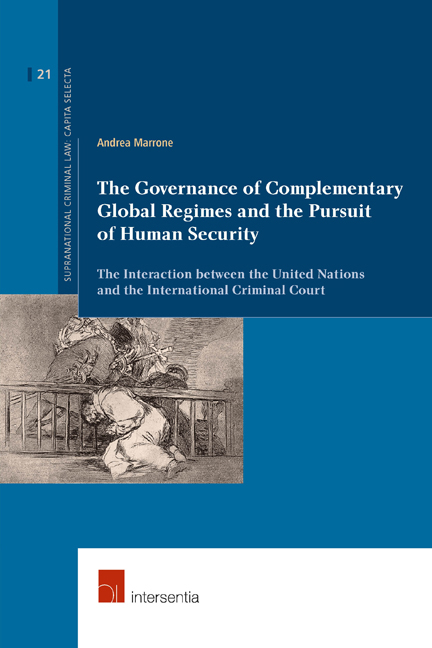 The Governance of Complementary Global Regimes and the Pursuit of Human Security
The Governance of Complementary Global Regimes and the Pursuit of Human Security from PART I - THE QUEST OF COMPLEMENTARITY AND THE DILEMMA OF HUMAN SECURITY
Published online by Cambridge University Press: 15 December 2017
PRELIMINARY REMARKS
The previous chapter wanted to shed some light on the transition of global regulatory frameworks fostering human security. It clarified the construction, meaning and subject matter of global regimes of legal and political nature dealing with international threats and crimes. It offered some background information of the emerging regime of international criminal justice and the foundation of its jurisdiction. It examined the normative and policy orientations of human security based on both the rule of international law and world politics. It focused on the paradigm shift of complementarity between global regimes and the interpretation of its meanings. It attempted to clarify the challenges and opportunities and the expectations of human security from different perspectives and views. It indicated that in order to progress with the architecture of governance fostering human security in conflict and post-conflict situations multilateral engagements are absolutely required. The multilateral perspective should expand further the principle of complementarity between statehood, sovereignty and the tools of international governance in accordance with the constitutions of the world community. This chapter examines the governance of peace and justice as tools of human security. It wants to stimulate further progress in accordance with the expectations of human security and the policy formulations required at domestic, regional and international levels responding to mass atrocity crimes. It underscores the prospects and the lasting debate of peace, justice and security, the unresolved governance issues, and the requirement of an integrated approach of governance of peace and justice.
This chapter explores the lasting debate between peace and justice and the unresolved governance issues between peace operations, law enforcement and civilian protection duties. It argues about the importance of interactions between complementary global regimes and underscores the preventive strategy of mass atrocity crimes required at global level. It recalls the background of the emerging regime of international criminal justice after decades of political efforts to reach consensus for the ratification of an international treaty, which would finally regulate the jurisdiction of a permanent criminal tribunal. As previously clarified, the Court was established with the scope to generate further jurisprudence after the judicial activity of the ad hoc UN tribunals, and among other purposes such as the preservation of the rule of law and human rights.
To save this book to your Kindle, first ensure [email protected] is added to your Approved Personal Document E-mail List under your Personal Document Settings on the Manage Your Content and Devices page of your Amazon account. Then enter the ‘name’ part of your Kindle email address below. Find out more about saving to your Kindle.
Note you can select to save to either the @free.kindle.com or @kindle.com variations. ‘@free.kindle.com’ emails are free but can only be saved to your device when it is connected to wi-fi. ‘@kindle.com’ emails can be delivered even when you are not connected to wi-fi, but note that service fees apply.
Find out more about the Kindle Personal Document Service.
To save content items to your account, please confirm that you agree to abide by our usage policies. If this is the first time you use this feature, you will be asked to authorise Cambridge Core to connect with your account. Find out more about saving content to Dropbox.
To save content items to your account, please confirm that you agree to abide by our usage policies. If this is the first time you use this feature, you will be asked to authorise Cambridge Core to connect with your account. Find out more about saving content to Google Drive.